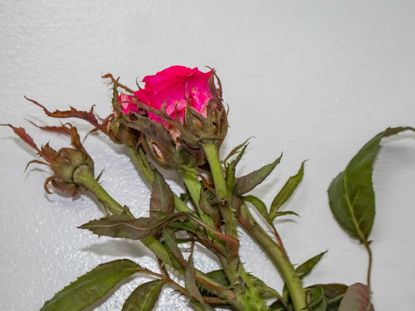What Is Rose Rosette Disease: Control Of Rose Rosette And Witches Broom In Roses


Rose Rosette disease, also known as witches' broom in roses, is truly a heartbreaker for the rose-loving gardener. There is no known cure for it, thus, once a rose bush contracts the disease, which is actually a virus, it is best to remove and destroy the bush. So what does Rose Rosette disease look like? Keep reading for information on how to treat witches' broom in roses.
What is Rose Rosette Disease?
Exactly what is Rose Rosette disease and what does Rose Rosette disease look like? Rose Rosette disease is a virus. The effect it has upon the foliage brings about its other name of witches' broom. The disease causes vigorous growth in the cane or canes infected by the virus. The foliage becomes distorted and frazzled looking, along with being a deep red to almost purple in color and changing to a brighter more distinct red. The new leaf buds fail to open and look a bit like rosettes, thus the name Rose Rosette. The disease is fatal to the bush and the longer one leaves it in the rose bed, the more likely it is that other rose bushes in the bed will contract the same virus/disease. Below is a list of some of the symptoms to look for:
- Stem bunching or clustering, witches' broom appearance
- Elongated and/or thickened canes
- Bright red leaves** and stems
- Excessive thorniness, small red or brown colored thorns
- Distorted or aborted blooms
- Under developed or narrow leaves
- Perhaps some distorted canes
- Dead or dying canes, yellow or brown foliage
- The appearance of dwarfed or stunted growth
- A combination of the above
**Note: Deep red colored leaves may be totally normal, as the new growth on many rose bushes starts out with a deep red coloration and then turns to green. The difference is that the virus infected foliage keeps its color and can also become mottled, along with vigorous unusual growth.
What Causes Witches Broom in Roses?
The virus is believed to be spread by tiny mites that can carry the nasty disease from bush to bush, infecting many bushes and covering much territory. The mite is named Phyllocoptes fructiphilus and the type of mite is called an eriophyid mite (wooly mite). They are not like the spider mite most of us are familiar with, as they are far smaller. Miticides used against the spider mite do not appear to be effective against this tiny wooly mite. The virus does not appear to be spread by way of dirty pruners either, but only by the tiny mites. Research indicates that the virus was first discovered in wild roses growing in the mountains of Wyoming and California in 1930. Since then it has been a case for many studies at plant disease diagnostic labs. The virus has recently been placed into a group known as Emaravirus, the genus created to accommodate a virus with four ssRNA, negative-sense RNA components. I won't go further into this here, but look up Emaravirus online for a further and interesting study.
Control of Rose Rosette
The highly disease resistant knockout roses seemed to be an answer for disease problems with roses. Unfortunately, even the knockout rose bushes have proven to be susceptible to the nasty Rose Rosette disease. First detected in the knockout roses in 2009 in Kentucky, the disease has continued to spread in this line of rose bushes. Due to the huge popularity of the knockout roses and the resulting mass production of them, the disease may well have found its weak link to spreading within them, as the disease is readily spread through the grafting process. Again, the virus does not appear to be able to spread by pruners that have been used to prune an infected bush and not cleaned before pruning another bush. This is not to say that one does not need to clean their pruners, as it is highly recommended to do so due to the spread of other viruses and diseases in such a manner.
How to Treat Witches Broom on Roses
The best thing we can do is to learn the symptoms of the disease and not buy rose bushes that have the symptoms. If we see such symptoms on rose bushes at a particular garden center or nursery, it is best to inform the proprietor of our findings in a discreet manner. Some herbicide sprays that have drifted over onto rosebush foliage can cause foliage distortion that looks very much like Rose Rosette, having the witches' broom appearance and the same coloration to the foliage. The tell-tale difference is that the growth rate of the sprayed foliage and canes will not be extremely vigorous as the truly infected bush will be. Again, the best thing to do when you are certain a rose bush has the Rose Rosette virus is to remove the bush and destroy it along with the soil immediately around the infected bush, which could harbor or allow overwintering of the mites. Do not add any of the infected plant materials to your compost pile! Be vigilant for this disease and act quickly if observed in your gardens.
Gardening tips, videos, info and more delivered right to your inbox!
Sign up for the Gardening Know How newsletter today and receive a free download of our DIY eBook "Bring Your Garden Indoors: 13 DIY Projects For Fall And Winter".

Stan V. Griep contributed to Gardening Know How for many years, and has been a Colorado Native Rosarian for over four decades. He is an American Rose Society Certified Consulting Master Rosarian in the Rocky Mountain District, and a member of the Denver Rose Society, the Loveland Rose Society, and the American Rose Society. He is Gardening Know How's in-house expert on all things roses.
-
 Elegant Exotics: 8 Beautiful Amaryllis Varieties That Will Brighten Any Holiday Display
Elegant Exotics: 8 Beautiful Amaryllis Varieties That Will Brighten Any Holiday DisplayWhether red, pink, white or variegated, the right amaryllis varieties can enhance any living space, especially during the holidays. We round up eight of the most exquisite
By Bonnie L. Grant
-
 Forage For Herbs: 7 Tasty And Safe Wild Herbs To Pick Close To Your Own Backyard
Forage For Herbs: 7 Tasty And Safe Wild Herbs To Pick Close To Your Own BackyardIn addition to growing your own herbal staples, did you know there are several wild options out there that are safe and tasty – and free? Try foraging these 7 wild herbs
By Amy Grant